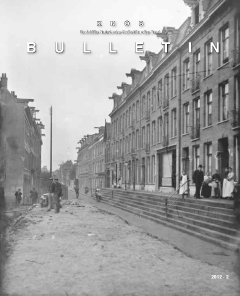Indexering ESCI / Scopus


Freek Schmidt: Maken en breken in stad, polder en buiten: ambities, reputaties en werkelijkheden. Guido Hoogewoud: Bastiaan de Greef en Willem Springer, architecten van een veranderende stad (1856-1890). Jos Smit: ‘Uit de groote schande van den revolutiebouw’. Over de moeizame waardering van laatnegentiende-eeuwse woningarchitectuur. David Mulder: Op Stadspeil in de polder: Wijk F in de Amsterdamse stadsuitbreiding. Over het ontstaan en de ontwikkeling van een buurtje in de Pijp. Inger Groeneveld: What’s in a name? Nieuw licht op Moulins hofstede, de vroegste aanleg van buitenplaats Elswout te Overveen.
[No abstract available]
In 1856 alderman for Public Works Isaäc Warnsinck (1811-1857) reorganized the municipal building company of Amsterdam, the Stadsfabriekambt. He appointed three principal officials according to their expertise: the city engineer, the city architect and the managing director of Public Works. This intervention was necessary, because due to lack of money and inefficient organisation, Amsterdam was not capable of maintaining the existing city, let alone of preparing itself to a new development. Amsterdam had been reduced to a mere shadow of itself and the water city with its stock of...
At the end of the nineteenth century the term revolutiebouw (jerry-building) had become generally accepted for anything that was not sound. Revolutiebouw – quick, cheap and insolid housebuilding – started more or less simultaneously in the rapidly growing Dutch cities. The phenomenon was widely spread, and just as widely accepted was the emotionally charged term revolutiebouw to characterize complete nineteenth-century districts. Well-known examples are the Hague Schilderswijk, Oude Westen and Oude Noorden in Rotterdam and the Amsterdam Kinker district and De...
In 1905 the Amsterdam municipal council outlined a city extension plan for the Binnendijksche Buitenveldertsche Polder south of district YY (better known as De Pijp) on the land that had been added to Amsterdam through the annexation of large parts of the neighbouring municipality Nieuwer-Amstel in 1896. This city extension plan, designed by Hendrik Petrus Berlage in 1900, replaced the never adopted engineer’s plan of ir. C.L.M. Lambrechtsen van Ritthem. Within a sober aesthetic framework Lambrechtsen provided solutions to a wide range of technical problems related to the practice of the...
Elswout Manor in the village of Overveen near Haarlem, is of great art-historical importance, particularly to the history of Dutch country estates and garden architecture. Although it was not until 1660, during its second period of habitation, that Elswout became renowned for its history as well as its striking Dutch classicist architecture, attributed to Jacob van Campen, the manor dates from 1633-1635.
This article deals with the overlooked first period (1633-1654) of Moulin’s Manor, as it was known then, and with the founder Carl du Moulin (1586/1588 to approximately 1667), a...


open access mogelijk gemaakt door Stichting OpenAccess
